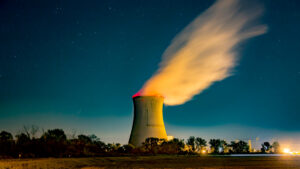Green Energy: AGL splits up coal and retail, Tesla banks on batteries

Pic: Matthias Kulka / The Image Bank via Getty Images
AGL confirms plan to separate coal from low-carbon offerings
Australia’s oldest energy generator AGL (ASX: AGL) has been sniffing the winds of change for a few years, standing firm amidst government pressure on its position to decommission the Liddell coal power station.
And that green energy evolution remains ongoing, with the company confirming plans today to divorce its existing coal plants into Accel Energy.
As part of the deal, Accel will be tasked with leading those assets through the energy transition to low-carbon power generation.
Accel will own Loy Yang A, Macquarie Generation and Torrens Island, and said it plans to prioritise “the responsible operation of these sites and facilitate their accelerated transition to low-carbon industrial energy hubs.”
It will also claim to be the country’s largest operator and offtaker of wind energy through the Macarthur, Hallett, Wattle Point and Oaklands Hill wind farms, potentially developing 1600MW of new wind projects.
Retailer AGL Australia would be “carbon neutral for scope 1 and 2 emissions” but will continue to contract power from Accel, which will own a passive 15-20% stake in AGL, in its early years.
The new AGL will absorb AGL’s electricity, gas, broadband and other retail services, own its hydro fleet and fast start gas-fired power stations, battery development and its 20 per cent investment in renewables firm PowAR.
“The impact of recent challenging market conditions on our financial performance emphasises that AGL Energy is now at an inflection point, as the transition of the energy sector accelerates, driven by the rapid evolution in renewables and decentralised energy technology, customer needs and community expectations,” AGL chairman Peter Botten said.
“After careful consideration, the Board has confirmed that AGL Energy should move forward as two independently-listed companies, as the Board believes this will be in the best interests of shareholders.”
“The clarity of purpose created by this change will protect shareholder value, enabling each business to focus on their respective strategic opportunities and challenges presented by the accelerating energy transition.”
AGL Energy share price today:
Green energy debate — Tesla calls for more batteries to firm up NEM
The Energy Security Board is getting ready to report to Australia’s energy ministers on proposed changes to the national electricity market (NEM) after 2025.
It has received its submissions from a host of energy players, clean energy advocates, coal plant owners, major customers and market participants, many of them simply fatigued by the seemingly never ending state of reform in the market as renewables are introduced at a growing pace.
Commentary has revolved around the proposed option of shifting the very new retailer reliability obligation (RRO) from the financial model introduced only two years ago to one based on physical capacity, something renewables advocates claim will induce coal-fired plants to stay in the market past their natural used by date.
Other critics, including some energy companies still operating coal power stations have queried the lack of cost-benefit analysis for this change.
The model seems to have favour with self-proclaimed “Minister for getting prices down” Angus Taylor, whose speech last month at the Australian Energy Conference contained no less than 9 uses of the Morrison Government’s new energy buzzword “dispatchable”.
It is strongly supported by EnergyAustralia, one of the big three energy companies alongside AGL and Origin.
EV giant and mega-battery peacocker Tesla was among the most strident ‘green energy’ companies in its submissions, saying battery storage systems were already equipped to deliver the service provided by “synchronous generation” from thermal plants.
“As the latest data from HPR (Hornsdale Power Reserve) shows, battery storage with grid-forming inverters have demonstrated their ability to replace the suite of essential system services historically provided by thermal plant, such as inertia and system strength,” Tesla wrote.
“Batteries using power electronics can create ‘virtual’ equivalents that offer a premium response with tune-ability,” the company said.
“This completely removes the justification for deploying synchronous condensers for these services. The Callide event in May 2021 highlighted just how effective this response can be in stabilising frequency through an inertial response using Tesla’s Virtual Machine Mode.”
Calix lauds CRC funding
Calix (ASX: CXL) owns and develops a unique calcination technology that reduces CO2 emissions in a variety of applications including the cement industry.
It has seen increasing favour from the market over the past few months, signing an MoU with spodumene producer Pilbara Minerals (ASX: PLS) in May around a midstream lithium chemical refinery JV, and securing a $1 million Federal Government grant for a biotech plant in Bacchus March, Victoria.
Today the Heavy Industry Low-carbon Transition Cooperative Research Centre, of which Calix is a key member alongside big players like FMG, South32 and Alcoa, was announced as the recipient of $39 million in government funding.
Calix shares were up 4.7% to $2.69 at 12.20pm EST, marking a cool ~250% gain over the past 12 months.
Calix share price today:
Related Topics
UNLOCK INSIGHTS
Discover the untold stories of emerging ASX stocks.
Daily news and expert analysis, it's free to subscribe.
By proceeding, you confirm you understand that we handle personal information in accordance with our Privacy Policy.








